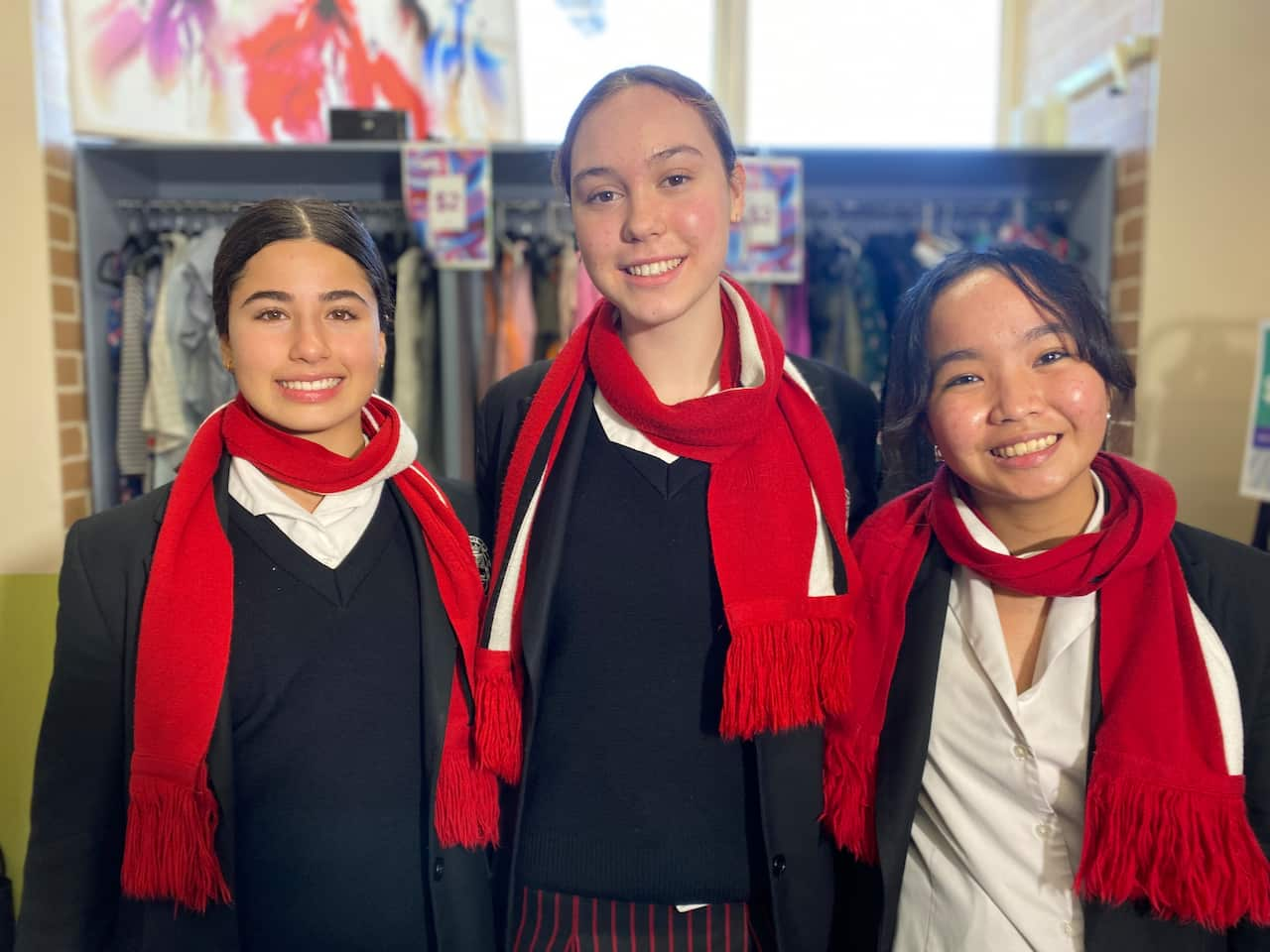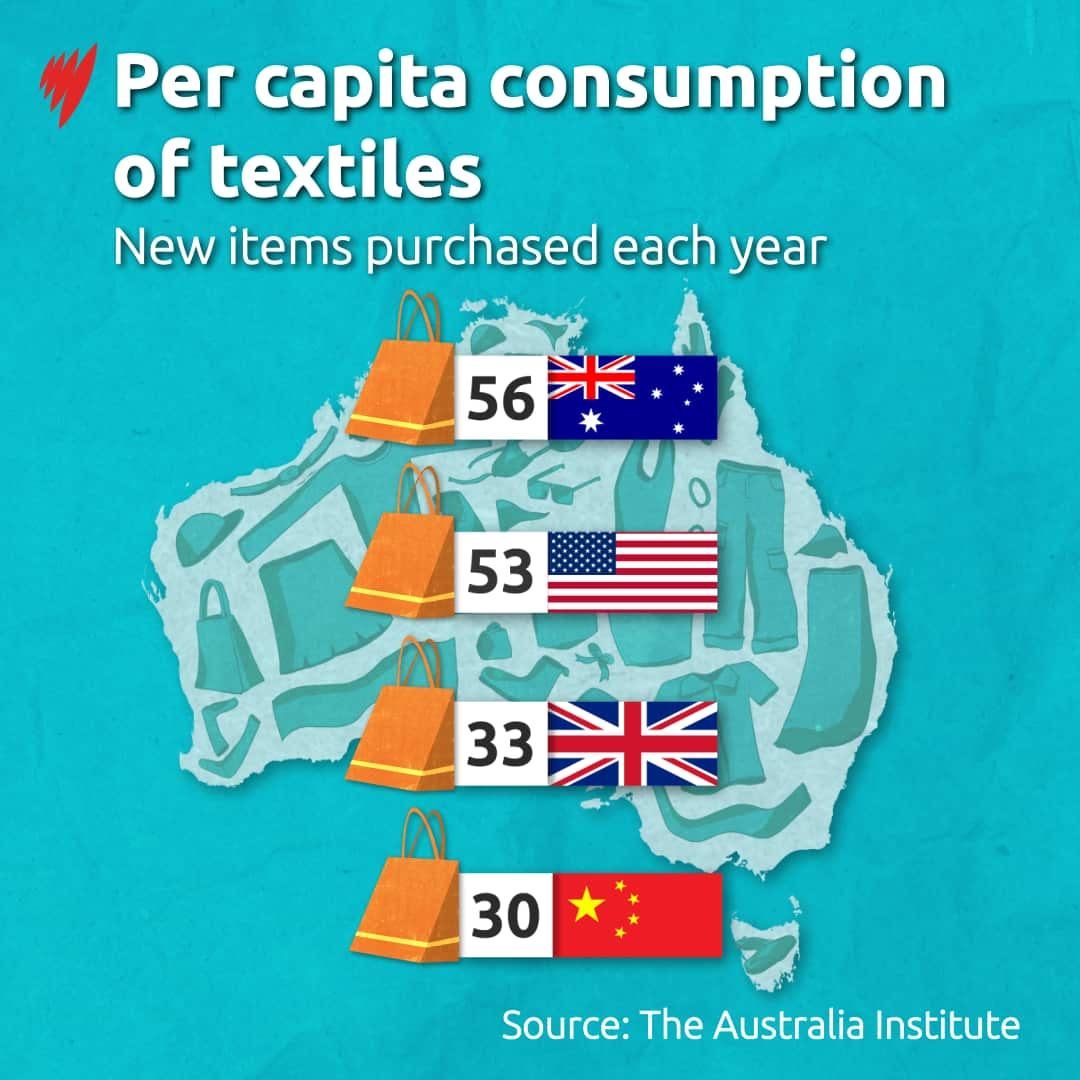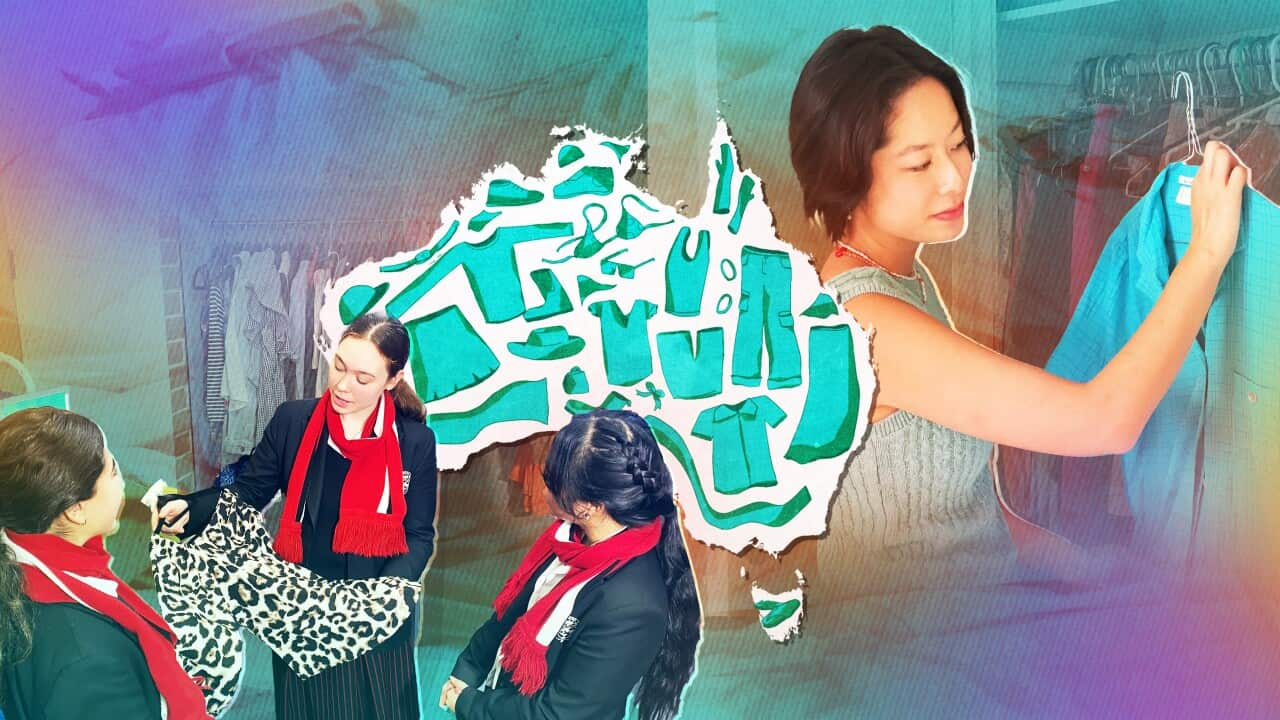Year 11 student Raquel Calandra feels the pressure of keeping up with ever-changing fashion trends.
As a young person, growing up in the digital age means greater exposure to those trends. Social media feeds are flooded with advertising, product unboxing, try-on videos and influencer partnerships.
“I go to a lot of parties and every single time I go out, I’m like, ‘I need a new outfit’,” said Calandra, a student at Santa Sabina College in Sydney’s inner west.
“It’s normal today. You can’t wear something twice.”
Enter ultra-fast fashion, characterised by even shorter production cycles and trends than its predecessor. It’s affordable, it’s accessible — and it’s everywhere.
“Online, on buses, on buildings — it’s always in your face,” said Year 12 student Lucy Gee.
“Trends come and go so quickly. I guess it’s a natural human instinct to follow them and [fast fashion] is so convenient and so cheap.”
These high-school students are on a mission to quit fast fashion. Source: SBS News
But this climate-conscious generation is also aware of the environmental impact of their consumption habits. Last year, the students had a moment of reckoning.
After learning that Australians were among the largest fashion consumers, Gee and a team of senior students at Santa Sabina decided to launch a pre-loved clothing store.
“We [realised] we can sell really cheap clothes, just like fast fashion, and we can also be really, really convenient,” Gee said.
The shop, Santa Style, is now a permanent fixture on campus, open two lunchtimes a week. The students also run an online store and an Instagram page.
With the cost of living crisis front of mind, they decided to cap prices at $20 — including designer label items such as Zimmermann, Aje, and Carla Zampatti.
“[You] bring something you’re not going to wear again and someone else can wear it. We’re not wasting things. [And] I can actually afford things here rather than buying a dress for $100 and wearing it once,” Calandra said.
Calandra and fellow student Emma Wong, also in Year 11, will take over operations next year after Gee and other senior students graduate.
This month, Wong has been visiting other schools in the area to promote the idea.
“They don’t need to be this massive corporation … [you can] really start off small to make a massive impact,” she said.
Australians revealed as world’s biggest fashion consumers
Australia has now overtaken the United States as the world’s biggest consumer of clothes, shoes and bags, on a per capita basis, according to research from the Australia Institute. Most of this is fast fashion that ends up in landfill.
The analysis, published last month, found that the average Australian buys around 56 new items each year, and the average cost of those items is $13 — far lower than the United Kingdom, the US, Japan, and Brazil.
Australia has overtaken the US as the world’s biggest consumer of clothes, shoes and bags, on a per capita basis. Source: SBS News
When it comes to discarding clothing, more than 200,000 tonnes of textiles end up in landfill in Australia each year — the equivalent weight of almost four Sydney Harbour Bridges.
Nina Gbor, circular economy and waste program director at the Australia Institute, said an additional 100,000 tonnes are exported to the Global South.
“We shouldn’t be sending clothing made of plastic fossil fuels to other countries to pollute their environments. We should reduce that at source and then recycle and reuse the stuff,” she said.
An industry on notice
It’s an issue Environment Minister Tanya Plibersek is seeking to address through a new initiative, which officially starts on Monday.
Speaking earlier this month at the initiative’s launch event in Sydney, Plibersek said curbing clothing consumption was “an incredible challenge for us as a country”.
“It’s a really serious environmental problem, particularly as we’re seeing a very high volume of very low-cost fashion,” she said.
The average cost of new clothing items purchased in Australia is $13. Source: SBS News
The goal of the scheme, known as Seamless, is to create circularity by 2030 by transforming the way clothing is made, used, reused, and recycled in Australia.
While it isn’t compulsory, 62 companies have signed on in the 12 months since the scheme was announced, including Big W, Cotton On, David Jones, Lorna Jane, Rip Curl, RM Williams, Sussan Group, and The Iconic.
From 1 July, member companies will be required to pay a four-cent levy for each new garment placed on the market.
The funds will go towards programs and training for businesses to support sustainable product design, reduce waste and educate consumers.
Gbor said this is a good start, but argued the levy is too low to change brand behaviour.
“It’s very pleasing to see that the government is doing something about clothing waste in this country, but unfortunately it’s not enough. We need [the levy to be] more like 50 cents per garment,” she said.
Gbor said the issue could also be tackled through a ban on the export of textile waste. She would like to see Australia adopt an approach similar to France, which is seeking to impose a 10 euro ($16) tax on each ultra-fast fashion item sold in the country, and ban the advertising of such products.
“We want to tax these fast fashion brands and invest that money into Australian businesses who are manufacturing using circular principles,” Gbor said.
Sustainability now a ‘consumer movement’
Australian consumers of all ages are increasingly considering the social and environmental impact of their purchases, according to Eloise Zoppos, research and engagement director at Monash Business School’s Australian Consumer and Retail Studies.
She said sustainability is no longer a trend, but a consumer movement.
“What we’re finding, both in our research and in the larger trend across Australia and globally, is, particularly [amid] the cost of living crisis, people are looking for new and different ways to engage in sustainable behaviours and really shop according to their values,” she said.
“More and more people are shopping for second hand or pre-owned goods. “
The trend is also emerging in the digital space. While social media is often criticised for promoting a culture of over-consumption, a growing wave of content creators are rallying against fast fashion.
Maggie Zhou, a Melbourne-based writer and podcaster, is one of them.
In 2019, she decided to switch her Instagram profile to one that promoted slow fashion.
Maggie Zhou is among a growing wave of content creators rallying against fast fashion. Source: SBS News
“Previous to that, I had been working with fast fashion brands, accepting gifted products, wearing their new clothes,” Zhou said.
“[It was] so fun, so sparkly and really alluring but after a while it left a sour taste in my mouth.”
Zhou said while fast fashion still dominates the influencer space, there has been notable progress in recent years.
“In Australia, there is still a small pool of us, but definitely with the rise of TikTok, I’ve been seeing so many creative people show off their up-cycling outfits, and how they go op-shopping. I think it’s growing, but growing very slowly.”
‘Wear the clothes that are in your wardrobe’
Most of the clothes in Zhou’s wardrobe are second-hand.
“I go to local op shops [and] consignment stores. And when I do make purchases of new items, I really try to be conscious of it. That means researching the brands, sitting with the decision before I make it.
“It can be hard. There are so many trends out there, but I really try to slow down my consumption and only buy what’s necessary.”
Zhou’s number one tip for those seeking to be more sustainable?
“Wear the clothes that are in your wardrobe,” she said.
“So many of us overlook pieces we have. Re-wear the clothes you have, take care of them and wear them for as long as you can.”
Gbor is also a big advocate of re-styling the items we already own.
“Re-styling means wearing one garment in multiple ways. Making those new combinations allows you to wear your clothes longer in different ways through layering and accessorising,” she said.
“You can have a brand new wardrobe without buying anything new.”
She said clothing swaps are another way to freshen up your wardrobe.
“You still get that dopamine hit, even though it’s not exactly brand new. It’s shopping for free and it’s diverting clothes from going to landfill.”




